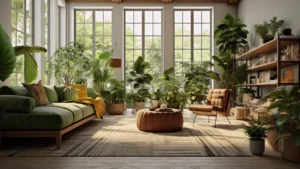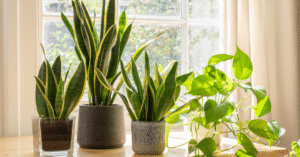Are you looking for low-maintenance plants to add color, texture, and life to your garden? If so, you’re in luck! Many easy-to-grow perennial flowers require little maintenance yet bring a lot of beauty. From fragrant white flowers to vibrant purple ones, these low-maintenance plants can thrive in full sun or part shade and will help create an outdoor paradise with minimal effort. Here we provide an overview of the ten best low-maintenance plants you can find at nurseries and garden centers. These flowering plants will add a touch of color and texture to any landscape while requiring little maintenance. So if you want a low-maintenance option for your outdoor space, read on!
Key Takeaways
Variety of Low-Maintenance Plants: Highlights ten easy-to-care-for plants suitable for various environments and care levels.
Adaptable to Lighting: These plants can thrive in different light conditions, from low to bright light.
Drought-Tolerant Nature: Requires infrequent watering, ideal for busy lifestyles or frequent travelers.
Air-Purifying Properties: Many featured plants, such as Spider Plants and Peace Lilies, help improve indoor air quality.
Mental Health Benefits: The presence of these plants can reduce stress and enhance overall well-being.
Factors in picking low-maintenance plants
When selecting low-maintenance plants, various factors must be considered to ensure they thrive in your home or garden. These factors include light, soil, water, space, and temperature requirements.
- Light Requirements
Plants vary in the amount of light they need for photosynthesis, growth, and flowering. For example, plants for example, plants such as the snake plant, ZZ plant, peace lily, and Chinese evergreen prefer low to medium light. Therefore, they can tolerate either indirect sunlight or artificial light. In contrast, plants like the rubber plant and dracaena require bright, filtered light to grow well. Therefore, it is essential to know the best light requirement for your plant and place it in an area that receives the appropriate amount of light.
- Soil Requirements
Most low-maintenance plants prefer well-drained soil that is rich in nutrients. Plants such as the spider plant, peace lily, and dracaena thrive in well-drained soil that is slightly acidic or neutral. On the other hand, plants like the snake and ZZ plants prefer well-drained, slightly alkaline soil. Therefore, it is essential to understand your plant’s soil requirements to ensure they grow healthy and vibrant.
- Water Requirements
Most low-maintenance plants are drought-tolerant and do not require frequent watering. For instance, the snake, ZZ, and Chinese evergreen plants need minimal watering, while the peace lily and spider plants thrive in moist soil. However, all plants need adequate water to grow, and it is essential to water them according to their specific requirements.
- Temperature Requirements
Low-maintenance plants have diverse temperature requirements that range from warm to cool. For example, the snake and ZZ plants prefer temperatures ranging from 55-90°F and can tolerate temperatures as low as 50°F. On the other hand, plants like the Boston fern require temperatures ranging from 50-85°F to grow well. Hence, monitoring your plant’s temperature is crucial to ensure it grows optimally.
- Space Requirements
When choosing low-maintenance plants, it is also vital to consider your plant’s size. Large plants such as rubber, Chinese evergreen, and dracaena require more space to grow, while smaller plants like the snake and ZZ plants are best suited for tight spaces. Therefore, you should choose a plan that fits your available space or plan to provide it with ample room to grow.
Best Low-Maintenance Plants for Your Home
Now that we have discussed the essential factors to consider when choosing low-maintenance plants let’s look at the best options for your home or garden. These ten plants are perfect for those who want to enjoy beautiful and vibrant greenery without the hassle of constant maintenance.
#1. Snake Plant

The snake plant, aka Sansevieria, is a popular low-maintenance plant known for its air-purifying properties. It can tolerate meager light to medium light and requires minimal watering, making it an excellent choice for beginners. It has stiff, upright leaves in shades of green, yellow, and silver.
#2. ZZ Plant

Also known as Zamioculcas zamiifolia, the ZZ plant is incredibly hardy and adaptable and thrives in low to medium light. It is drought-tolerant and can go without water for several weeks, making it an ideal choice for people who travel frequently. In addition, theIn addition, the ZZ plant’s glossy, dark green leaves can add a touch of tropical elegance to any space.
#3. Chinese Evergreen

The Chinese evergreen, or Aglaonema, is a versatile plant that can grow in low to bright light and is tolerant of fluctuating temperatures. It prefers slightly acidic soil and doesn’t require frequent watering, making it a low-maintenance option. Its variegated leaves come in shades of green, silver, and even pink.
#4. Peace Lily

The peace lily, or Spathiphyllum, is a popular houseplant admired for its lush, dark green foliage and white flowers. It grows well in low to medium light and prefers moist soil. However, it is essential to note that the peace lily is toxic to pets, so caution is necessary if you have furry friends at home.
#5. Spider Plant

The spider plant, or Chlorophytum Comosum, is a classic houseplant renowned for its adaptability and air-purifying abilities. It can tolerate low to bright light and prefers slightly moist soil. Spider plants produce cascading foliage in shades of green, yellow, and white.
#6. Dracaena

Dracaena is a diverse plant family with various species, such as the dragon tree and corn plant. They are great low-maintenance options and easy-to-grow plants that can grow in low to bright light and prefer well-drained soil. However, they can be toxic to pets, so be mindful of their placement if you have furry friends at home.
#7. Rubber Plant

The rubber plant, or Ficus elastic, is a sturdy and adaptable plant that can grow in low to bright light and requires minimal watering. Its large, glossy leaves come in shades of green and burgundy, adding a touch of drama to any space. It can also grow tall, so it’s best suited for larger rooms or offices.
#8. Pothos

The pothos, or Epipremnum aureum, is a trailing plant admired for its easy care and variegated leaves. It can tolerate low light to medium light and prefers slightly moist soil. Pothos are also known for their air-purifying qualities and can help remove toxins from the air.
#9. Boston Fern

The Boston fern, or Nephrolepis exaltata, is a classic houseplant admired for its lush, trailing fronds. It can tolerate low to bright light but prefers cooler temperatures and high humidity. Boston ferns require frequent watering to keep their soil moist, making them the best indoor plants suited for more attentive plant owners.
#10. Aloe Vera

Aloe vera is a versatile and low-maintenance plant with numerous health benefits. It can grow in low to bright light and prefers well-drained soil. As a result, Aloe vera doesn’t require frequent watering and can even go without water for several weeks. Its fleshy leaves are also used in various skin and beauty products for their moisturizing qualities.
These plants are excellent options for people who want to enjoy lush, vibrant greenery without the hassle of constant maintenance. Their diverse foliage and air-purifying qualities can add a touch of nature and tranquility to any space. However, consider their specific light, soil, water, temperature, and space requirements to ensure they thrive in your home or garden.
Additional Low-Maintenance Plants
In addition to the previously mentioned plants, there are various other low-maintenance options for your garden or landscape. Succulents are a great choice, as they require little water and can thrive in full sun to part shade. Cacti are also easy to care for and can add a unique touch to any outdoor space. Air plants are another low-maintenance option, as they don’t require soil and can be displayed creatively.
For those looking to add a larger plant to their garden or landscape, the Monstera Deliciosa and Philodendron are great options. These plants are easy to grow and can tolerate a range of light conditions, from full shade to full sun. They also have attractive foliage that can add visual interest to your outdoor space.
When looking for low-maintenance plants, it’s essential to consider their individual needs and how they will fit into your overall landscape design. For example, some plants may require specific soil types or watering schedules, while others can thrive in various conditions. Nurseries and garden centers can be great resources for finding the perfect low-maintenance plants.
How to Care for Low-Maintenance Plants
Low-maintenance plants are the perfect addition to any garden or landscape due to their ease of care and ability to thrive without much attention.

Watering
When it comes to watering, these plants typically require less frequent watering since they can tolerate drought and do not need to be constantly moist. Howeverensuringre, they receive enough water when first plants are vital d to establishing good root growth.
Fertilizing
Fertilizing low-maintenance plants is also a simple task. Many plants do not require frequent fertilization; adding too much can harm their growth. Applying a slow-release fertilizer in the spring and only as needed throughout the growing season is recommended.
Pruning & Cleaning
Pruning and cleaning these plants is another low-maintenance task. While some may require occasional pruning to maintain their shape or remove dead branches, most low-maintenance plants can grow naturally without issue. Also, cleaning the plants of debris or dead leaves can help prevent pests and diseases.
Repotting
Repotting is also typically not required for low-maintenance plants. Many are happy to grow in the same container or location for multiple years without issue. However, if a plant begins to outgrow its space or shows signs of stress, repotting in fresh soil may be necessary.
Caring for low-maintenance plants is easy and stress-free. By providing them with the proper amount of water, fertilizer, pruning, cleaning, and occasionally repotting, these plants can continue to thrive and add beauty to any garden or landscape without much effort on your part.
Common Problems and Solutions for Low-Maintenance Plants
Low-maintenance plants can easily thrive in your garden with minimal effort, but sometimes they may encounter problems.
- Overwatering
Overwatering is one of the most common problems, and it occurs when you water the plants more than necessary, leading to root rot and leaf yellowing. To avoid overwatering, ensure the soil is well-drained and water only when the top inch of the earth is dry.
-
Underwatering
Underwatering is also a common problem, and it occurs when you don’t water the plants enough, causing the soil to dry out and the leaves to wilt. To avoid underwatering, water the plants deeply and less frequently, and make sure the soil is moist but not waterlogged.
-
Pests & Diseases
Pests and diseases can also affect low-maintenance plants, but the good news is that they are relatively easy to control. First, look for common problems such as aphids, spider mites, and whiteflies, and treat them with insecticidal soap or neem oil. As for diseases, practice good sanitation by removing any infected plant parts and ensuring the healthy plants are not overcrowded to prevent the spread of diseases.
-
Brown tips
Brown tips can occur in low-maintenance plants, but they are usually not a cause for concern. Brown tips can result from dry air, nutrient deficiencies, or even natural aging and can be easily trimmed with scissors or pruned back to keep the plant looking healthy.
Benefits of Having Low-Maintenance Plants at Home

Having low-maintenance plants at home has numerous benefits beyond just adding aesthetic appeal to your garden or home. These plants require minimal care, making it easy for homeowners to enjoy their beauty without dedicating excessive time and energy. Low-maintenance plants are also excellent options for those new to gardening and lacking plant upkeep experience.
One of the most significant benefits of low-maintenance plants is their potential to improve air quality. Plants naturally remove airborne toxins, pollutants, and volatile organic compounds (VOCs) from the air, thus helping to purify it. According to a study conducted by NASA, certain indoor plants, such as snake plants, spider plants, and peace lilies, can remove up to 87% of air pollutants in less than 24 hours. This makes them an ideal option for people living in urban areas or those exposed to high pollution levels at work.
Apart from air quality, low-maintenance plants can also enhance mental health, reduce stress, and boost productivity. Studies have shown that being surrounded by plants can reduce stress levels and increase attention span and productivity. Plants can create a sense of calm and relaxation, significantly improving mental well-being. Additionally, their natural beauty and scent can stimulate the senses, thus promoting peace.
Conclusion
Low-maintenance plants can be a great addition to any home, offering numerous benefits such as improved air quality, enhanced mental health and well-being, stress reduction, and increased productivity. With so many options available at nurseries and garden centers, homeowners can choose from various low-maintenance plants that best suit their preferences. By providing adequate sunlight and following proper care instructions for each plant type, anyone can easily enjoy the beauty of these unique additions in their homes with minimal effort.
Frequently Asked Questions
What are some low-maintenance plants for beginners?
Snake plant, ZZ plant, and peace lily are great for beginners due to their minimal care needs.
Do low-maintenance plants need much light?
It varies. Snake and ZZ plants tolerate low light, while others like rubber plant need bright light.
How often should I water low-maintenance plants?
Water only when the soil's top inch is dry. Frequency depends on the plant type.
Are there any low-maintenance plants that purify air?
Yes, snake plants, spider plants, and peace lilies are known for air purification.
Can low-maintenance plants grow in any soil?
Most prefer well-drained, nutrient-rich soil. Soil pH requirements vary by plant.
What temperature is best for low-maintenance plants?
Ideal temperatures vary. For example, snake plants prefer 55-90°F.
Do I need to fertilize low-maintenance plants often?
Generally, they require less fertilizer. A slow-release fertilizer in spring is sufficient.
Can low-maintenance plants help with stress?
Yes, having plants like peace lilies can reduce stress and improve mental well-being.
What are the signs of overwatering in plants?
Overwatering can lead to root rot and yellowing leaves.
Are all low-maintenance plants safe for pets?
No, some like peace lilies and dracaena are toxic to pets. Always check plant safety.
Sources
https://extension.oregonstate.edu/gardening/techniques/environmental-factors-affecting-plant-growth
https://www.petalrepublic.com/best-soil-mix-for-peace-lily-plants/
https://www.canr.msu.edu/news/drought_tolerant_plants_save_water_money_and_time
https://www.greenhousegrower.com/production/plant-culture/special-series/monitoring-the-greenhouse-environment/
https://www.sciencedaily.com/releases/2022/03/220307113115.htm
https://www.washingtonpost.com/wellness/2022/06/06/how-houseplants-can-boost-your-mood/













